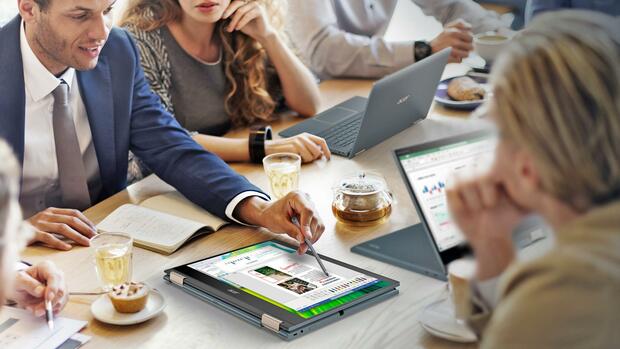However, the concept differs from the competition: users access their applications via the Internet – the operating system is reduced to a minimum. As a result, the requirements for the hardware decrease, and the device is quickly available after startup. However, without a stable Internet connection, the devices quickly reach their limits.
There is a reference design that all manufacturers must adhere to. This makes it possible for Google to regularly play out new versions of the operating system. These are not update orgies like with Windows: the next time the computer boots up, everything has already happened in the background.
The software offer is different from the other operating systems. As a rule of thumb, everything that is based on the Internet has good chances. In addition, it is possible to install apps for Android devices on some modern Chromebooks, provided that the system administrator of the employer has not prohibited this. Linux programs are now also running on the devices.
Some examples: The video service Netflix runs in the browser, and you can also install the Android version, which offers download options for watching movies offline. Microsoft has its own version of Microsoft 365 for Chromebooks on offer (formerly Office 365). And then there are the numerous Google applications, whether for word processing, e-mails or appointment management, for videos, music and games.
A full-blown Photoshop, on the other hand, doesn’t run on Chrome OS devices. On the one hand, the resource consumption is too high, on the other hand, the installation hurdles are insurmountable. If you don’t want to do without it, you can try an Android version of the software for simpler tasks, such as Photoshop Express, or use alternatives such as Pixlr or Canva.
Chromebook Security: Clean Reboot
What you don’t have to worry about today, or at least a little, is security. Chrome OS is considered resistant to viruses and other malicious software. The reason is simple: when the device is turned off, all memory, including the operating system, is erased. Only at the restart it will be re-recorded again. Whatever has settled in is gone for the time being.
If you want to be particularly sure, you work in the “guest” mode, not as an administrator. There is no longer a shred of information left when switching off, and software cannot install itself at all because of the lower access rights. Ransomware that has found its way onto a Chrome computer is simply erased when it is turned off.
All Chromebooks have a security chip, called Trusted Platform Module (TPM) in technical jargon, which increases security when rebooting. By the way, this will also be mandatory for Microsoft PCs starting with Windows 11.
Chromebook maintenance: beware of the expiration date
Chromebooks have a built-in expiration date of eight years. After that, you will no longer receive software updates. After a short time, they are no longer useful for serious work, because the Chrome browser is no longer updated. A vicious circle: Without the current version, many universities, schools, authorities and companies often no longer allow computers on their pages.
Buyers should take this into account. Especially online, whether new or used, supposedly current Chromebooks are offered, which have already spent five or six years in the warehouse and will become old iron after two years. Google has its own website on which every model with year of manufacture is listed. This should be visited in advance for second-hand purchases.
Google wants to remove this limitation and separate the updates from the browser in Chrome OS. Then the devices will be fun much longer. But, unfortunately, it’s not so easy, as Google manager Alexander Kuscher confirms on request.
The operating system and browser are deeply interwoven and must be carefully unwound again. He can’t say when it’s time. Kuscher assures: “It’s our turn.“ But old Chrome machines will no longer benefit from this.
Hardware of the Chromebooks: from cheap to noble, everything is included
Chromebooks are already cheap to have. However, devices up to 300 euros have some limitations: they usually have comparatively weak processors and rarely more than four gigabytes of main memory. This is enough if you only want to keep a few browser windows open at the same time. Otherwise, however, the systems are quickly exhausted.
In the lower price category, touchscreens are also hard to find. This is unfortunate when users want to run their favorite apps from the Android smartphone on the Chromebook – the programs are designed for finger operation.
For 300 to 600 euros, buyers get devices with a metal case and an attractive appearance. Intel’s mid-range chips of type I3 and I5 or Pentium are used as processors, which can cope with 20 open browser windows. Also, because it is better not to accept a device with less than eight gigabytes of main memory in the price range.
For disk storage, the lower limit is 64 GB, sometimes there is 128 GB. Street fighters and other frequent travelers who want or need to work offline on a regular basis should strike. At interfaces you can now already request four USB posts. Since the processors can handle television images, there is sometimes an HDMI port for transmitting the images.
While Chromebooks for 600 euros and more were previously virtually unknown, today each of the major suppliers has such a model in their range, since Chromebooks also find their place on executive desks. Noble cases, designer models and the most powerful processors can be asked for this money. Full HD and touch are standard here.









